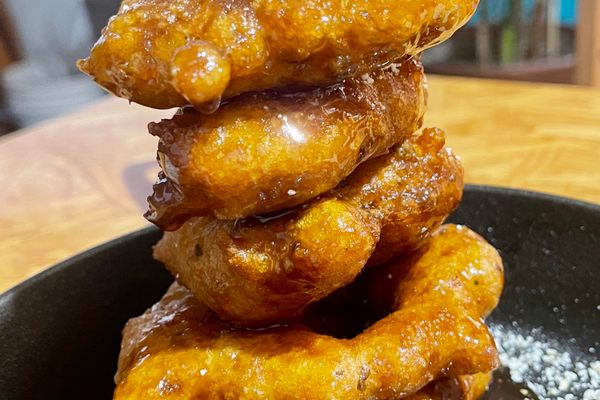The maca root’s ideal environment is an altitude of 13,000 feet in the Andes. Though Peruvians have used the plant as a staple crop for thousands of years, it has recently developed a reputation elsewhere as a superfood.
In the harsh climate of its native habitat, maca was one of the few plants Andean plateau-dwellers could grow successfully. The Incas, who cooked it in soups, ate it to fuel themselves before battle. Modern-day Peruvians still eat maca cooked in huatias, or earthen ovens. They also turn it into cocktail flavoring and a version of traditional South American chicha—a weak beer that ancient brewers prepared by chewing the starch to initiate fermentation. Residents of Huancayo, Peru, are particular fans of maca-based jams and puddings.
Though the fresh tuber is edible, chefs (especially ones far from the Andes) get more use out of its dried form, because maca is exported as a powder. Most often, locals blend the dehydrated root into beverages and soups. But this versatile, shelf-stable powder is also used to bake breads, cakes, and cookies. It even thickens sweet porridge and provides a coffee substitute when roasted.
South Americans also view maca as medicine. Quechua Indians, descendants of the Incas, have used the radish-family plant in healing since ancient times. The root—high in copper, calcium, and iron—is said to increase fertility and energy. Women who seek to become pregnant, ease menopause symptoms, or alleviate menstrual problems are prescribed maca, as are men with erectile dysfunction. Farmers feed it to livestock for increased chances of fertility. People suffering from chronic fatigue, anemia, osteoporosis, and other depleting conditions also use it to treat their illnesses.
Outside Peru, health-conscious consumers add maca powder to smoothies, oatmeal, and desserts. While Western fans liken the aroma to malty caramel or butterscotch, the tuber’s flavor doesn’t impress everyone. Many describe the powdered root as “earthy.” One reviewer even compared it to “slightly nutty wood shavings that have rotted.”
Though science has yet to substantiate many of the health claims surrounding maca, preliminary research has demonstrated effects beyond a placebo. Initial studies suggest that it may benefit postmenopausal women, in particular. Several millennia of medicinal use might just be rooted in some ancient truth, after all.
Written By
 rachelrummel
rachelrummel
Edited by
Sources
- www.healthline.com/nutrition/benefits-of-maca-root#section2
- www.huffingtonpost.com/entry/maca-recipes-and-benefits_us_5898a2d3e4b0c1284f270d6f
- beta.latimes.com/health/la-he-the-new-superfoods-20160711-snap-story.html
- www.fao.org/docrep/t0646e/T0646E0h.htm#Maca
- www.ncbi.nlm.nih.gov/pmc/articles/PMC4392557/
- www.ncbi.nlm.nih.gov/pubmed/18784609
- www.thecut.com/swellness/2016/08/maca-benefits-side-effects.html
- books.google.com/books?id=t22vBQAAQBAJ&printsec=frontcover&dq=Edible+Medicinal+and+Non+Medicinal+Plants&hl=en&sa=X&ved=0ahUKEwjvytSCtYDZAhWNY98KHU_pB7UQ6AEIPzAE#v=onepage&q=maca&f=false
The Atlas Obscura Podcast is Back!


















